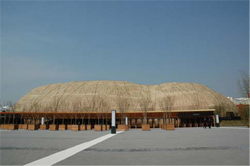What is the EDS Bamboo Design Project?
This is a project aimed at fostering design instructors who will serve as leaders in the creation of sustainable societies. Specifically, the project focuses on bamboo and involves the production of prototypes of buildings, furniture, etc. using bamboo. In Indonesia, activities will be centered on assistance for the building of a self-sustaining economy and assistance in disaster reconstruction.
Period: October 1, 2007 - March 31, 2010
EDS technology
This technology involves applying a special heat processing to timber materials, thereby, through tissue changes inside the wood, increasing its strength and processability and improving the effectiveness of scrap wood and timber obtained from the periodic thinning of forests.
EDS-processed timber has little warping and bending, displays excellent insecticide and preservative effects, and produces little resin. Also, it is more durable, easier to process, and strong enough for nails to be inserted at the ends or knots.

At Expo 2005, Aichi, Japan (held from March 5 to September 25, 2005, EDS-processed bamboo was used instead of the conventional steel frame for the exterior of the Japan Pavilion Nagakute, which measured 90 meters in length, 19 meters in height, and 70 meters in width. It thus became the first structure in the world to be built solely of bamboo. EDS is a technology that the United Nations Industrial Development Organization (UNIDO) aims to transfer to developing countries.
What is the "Contemporary GP"?
The Japanese Ministry of Education, Culture, Sports, Science and Technology (MEXT) sets themes in response to policy issues with strong social demands and, from among the applications received from universities, selects especially outstanding educational projects (activities) for financial assistance.
